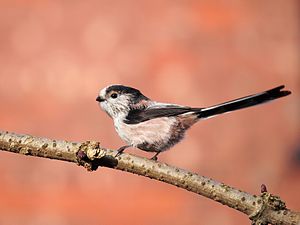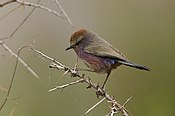Αιγιθαλίδες
| Αιγιθαλίδες | ||||||||||||||
|---|---|---|---|---|---|---|---|---|---|---|---|---|---|---|
 | ||||||||||||||
| Συστηματική ταξινόμηση | ||||||||||||||
|
Γεωγραφική κατανομή κ α ι ενδιαίτημα
[Επεξεργασία | επεξεργασία κώδικα]Περιγραφή
[Επεξεργασία | επεξεργασία κώδικα]
Συμπεριφορά
[Επεξεργασία | επεξεργασία κώδικα]Διατροφή
[Επεξεργασία | επεξεργασία κώδικα]Bushtits are insectivorous, primarily eating insects and other invertebrates [5] such as leafhoppers, treehoppers, aphids, scale insects, and caterpillars.[6] Plant material, such as berries or seeds, is taken occasionally during the winter.[6] The family generally forages arboreally, usually in the shrub layer or canopy, and seldom visits the ground. Prey is generally gleaned from branches, leaves and buds. Less frequently, prey is taken in the air. While foraging, this agile family may hang upside down on branches (although this behaviour is not thought to occur in the tit-warblers) and even manipulate branches and leaves in order to locate hidden food.[1]
Σ τ η φωλιά
[Επεξεργασία | επεξεργασία κώδικα]The family generally has a monogamous breeding system, however there is some evidence that the American bushtit may be frequently polyandrous and occasionally polygynandrous or polygynous.[7][4] Pairs may be aided by helpers, where a related or unrelated individual (or more than one) helps the established pair raise the young. This has been recorded in at least four of the species; further research is required to see if the behavior carries over to other members of the family.[1][3][7][4] Aegithalids make domed or hanging, bag-like nests of woven cobwebs and lichen, which they line with feathers. Many nests are constructed in trees with thick foliage, making them difficult for predators to find.[5] However, the American bushtit often places nests such that it is entirely exposed. [4]The clutch comprises 5 to 10 white eggs, which in many of the species have red speckles. Adults incubate the eggs for 13 to 14 days; young stay in the nest for 16 to 18 days. In at least four of the species (the long-tailed tit, the black-throated bushtit, and silver-throated bushtit), only the female incubates.[2][3] Young chicks are fed exclusively on insects and spiders.[1]
Ταξινομική
[Επεξεργασία | επεξεργασία κώδικα]The family Aegithalidae (as a subfamily Aegithalinae) was introduced by the German naturalist Ludwig Reichenbach in 1850.[8][9] The name comes from the Ancient Greek word aigithalos for a tit. Aristotle recognised three species: the long-tailed tit, the great tit, and the Eurasian blue tit.[10]
The pygmy bushtit is placed in this family because it moves around in flocks and its nests resemble the long-tailed tits', but information about it is so scanty that the placement is only provisional.[2] The Burmese bushtit is sometimes treated as conspecific with the black-browed bushtit.[1] The American bushtit was once thought to belong to the chickadee family, but it has distinctive behavioral habits, especially when it comes to nesting.[6]
There are 13 species in 3 genera.[11][12][13]
| Image | Genus | Living species |
|---|---|---|

|
Leptopoecile Severtzov, 1873 |
|

|
Psaltriparus Bonaparte, 1850 |
|
 |
Aegithalos Hermann, 1804 |
|
Παραπομπές
[Επεξεργασία | επεξεργασία κώδικα]- ↑ 1,0 1,1 1,2 1,3 1,4 Harrap, Simon (2008). «Family Aegithalidae (Long-tailed Tits)».
Σ τ ο : del Hoyo, Josep· Elliott, Andrew· Christie, David. Handbook of the Birds of the World. Volume 13, Penduline-tits to Shrikes. Barcelona: Lynx Edicions. σελίδες 76–101. ISBN 978-84-96553-45-3. - ↑ 2,0 2,1 2,2 2,3 Perrins, Christopher M. (2003). «Long-tailed Tits»
 .
. Σ τ ο : Perrins, Christopher. The Firefly Encyclopedia of Birds. Firefly Books. σελίδες 556–557. ISBN 1-55297-777-3. - ↑ 3,0 3,1 3,2 3,3 Li, J.; Lv, L.; Wang, Y.; Xi, B.; Zhang, Z. (2012). «Breeding biology of two sympatric Aegithalos tits with helpers at the nest». Journal of Ornithology 153 (2): 273-283. doi:. https://www.researchgate.net/publication/251404367.
- ↑ 4,0 4,1 4,2 4,3 4,4 Sloane, S.A.: «Bushtit»
σ τ ο Birds of North America (ε π ι μ . A. Poole, P. Stettenheim, F. Gill), Ένωση Αμερικανών Ορνιθολόγων, Φιλαδέλφεια 2001 - ↑ 5,0 5,1 Perrins, C. (1991). Forshaw, Joseph, επιμ. Encyclopaedia of Animals: Birds. London: Merehurst Press.
σ ε λ . 202. ISBN 1-85391-186-0. - ↑ 6,0 6,1 6,2 Kaufman, K. (1996). Lives of North American Birds. Houghton Mifflin: Boston.
- ↑ 7,0 7,1 Sloane, Sarah A. (October 1996). «Incidence and origins of nest supernumeraries at Bushtit (Psaltriparus minimus) nests». Auk 113 (4): 757-770. doi:. https://sora.unm.edu/sites/default/files/journals/auk/v113n04/p0757-p0770.pdf.
- ↑ Reichenbach, Ludwig (1850). Die vollständigste Naturgeschichte der Vögel (
σ τ α Γερμανικά). Apt. II Band I. Δρέσδη: Expedition der Vollständigsten Naturgeschichte. Plate LXII. - ↑ Bock, Walter J. (1994). History and Nomenclature of Avian Family-Group Names. Bulletin of the American Museum of Natural History. Number 222. New York: American Museum of Natural History. σελίδες 153, 253. hdl:2246/830.
- ↑ Jobling, J.A. (2018). del Hoyo, J.· Elliott, A.· Sargatal, J.· Christie, D.A.· de Juana, E., επιμ. «Key to Scientific Names in Ornithology». Handbook of the Birds of the World Alive. Lynx Edicions. Ανακτήθηκε στις 21 Μαρτίου 2018.
- ↑ Gill, Frank· Donsker, David, επιμ. (2017). «Bushtits, leaf warblers, reed warblers». World Bird List Version 8.1. International Ornithologists' Union. Ανακτήθηκε στις 21 Μαρτίου 2018.
- ↑ «IOC World Bird List 12.1». IOC World Bird List Datasets (
σ τ α Αγγλικά). doi:10.14344/ioc.ml.12.1. Ανακτήθηκε στις 29 Ιανουαρίου 2022. - ↑ Päckert, Martin; Martens, Jochen; Sun, Yue-Hua (2010-06-01). «Phylogeny of long-tailed tits and allies inferred from mitochondrial and nuclear markers (Aves: Passeriformes, Aegithalidae)» (
σ τ α αγγλικά). Molecular Phylogenetics and Evolution 55 (3): 952–967. doi:. ISSN 1055-7903. https://www.sciencedirect.com/science/article/pii/S1055790310000266.
- Harrap and Quinn: Tits, Nuthatches and Treecreepers, ISBN 0-7136-3964-4
